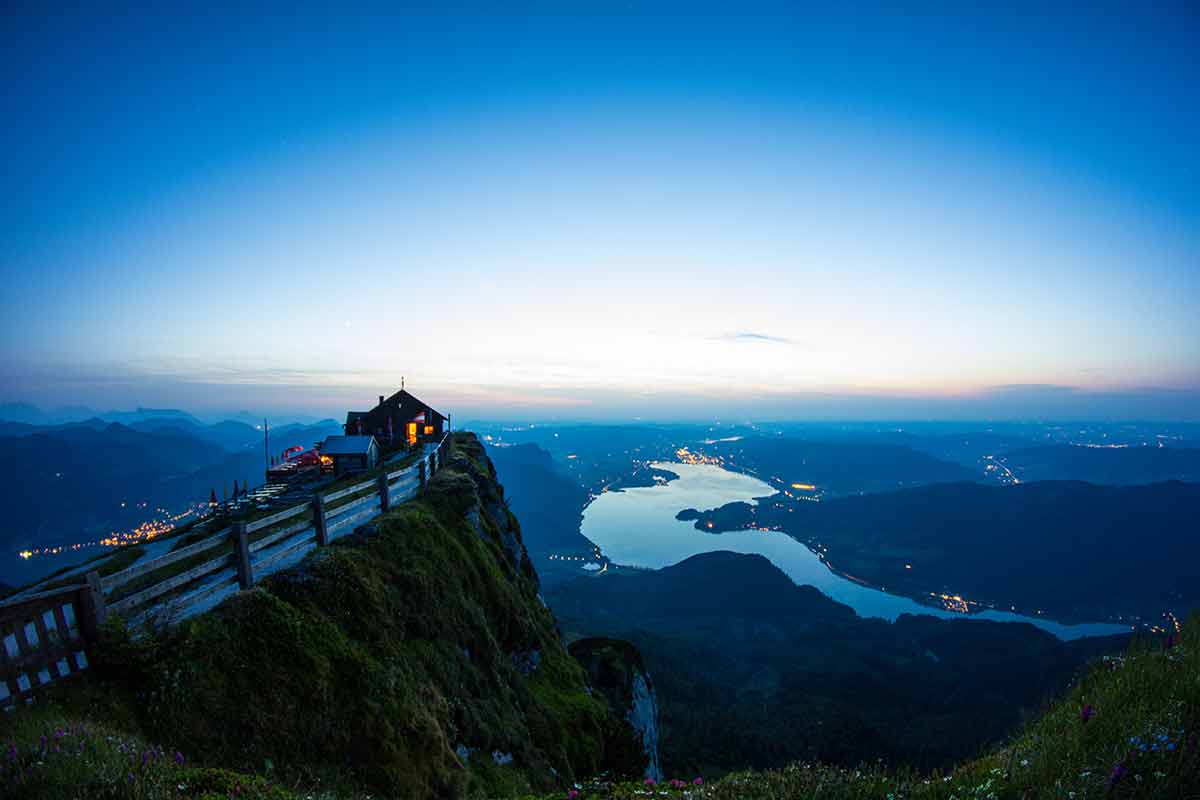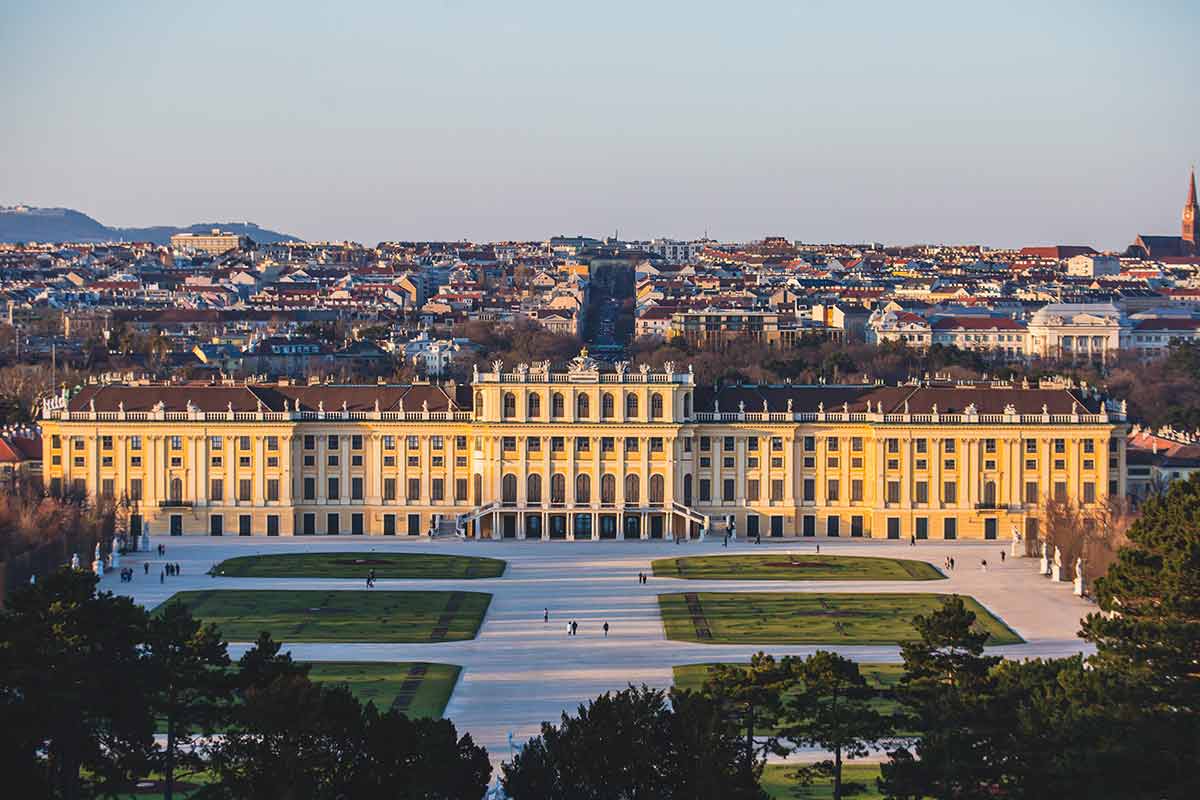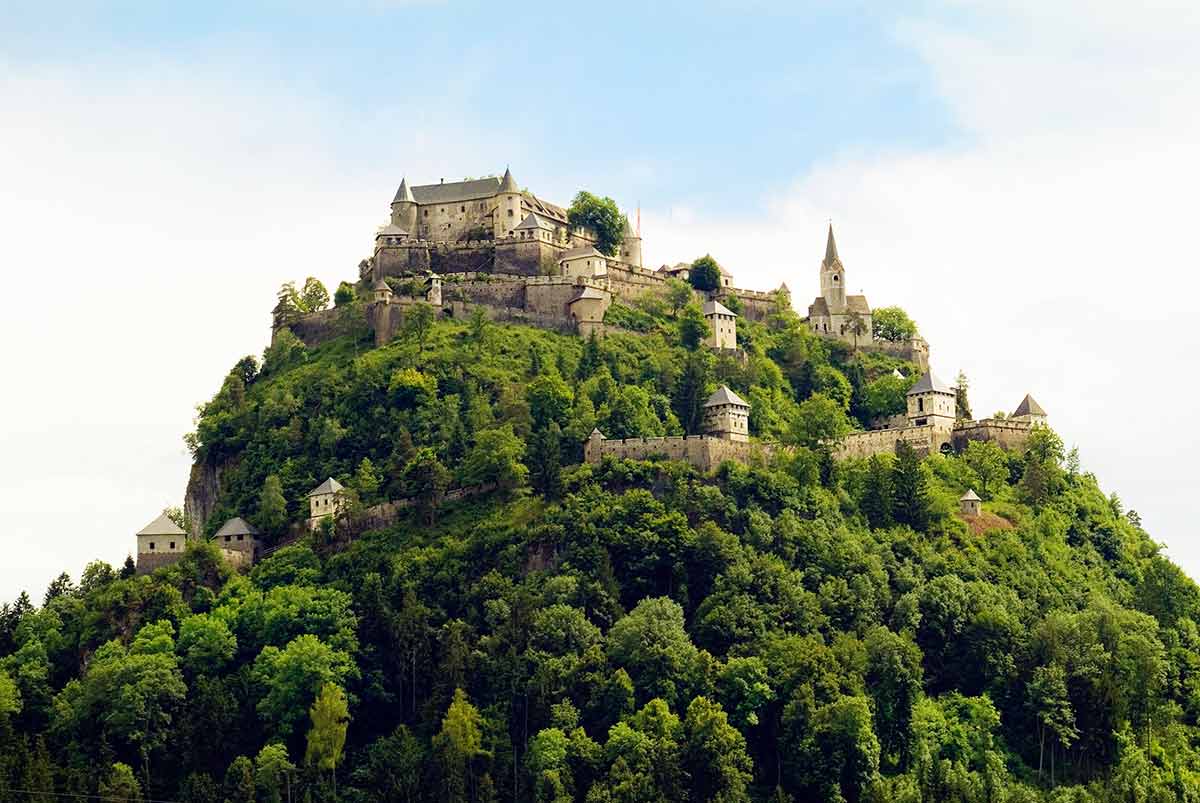Austria is the land of snow, world-famous composers, alpine ski slopes and strudel. For many years, Austria has typically been a go-to location for skiing and snowboarding. More recently, its cities have developed a young, vibrant, cultural scene attracting people away from the slopes to visit bars, cafes, museums and other famous Austrian landmarks.
When in Austria stop by an old-fashioned cafe or bakeries for a slice of sachertorte, a world-famous chocolate cake made with delicate layers of chocolate cake and apricot jam. Austria is famous for The Sound of Music, and fans will revel in the museums and tours dedicated to this musical. If musicals aren’t for you, head to one of Austria’s opera houses or concert halls to listen to classical music by Hayden or Mozart.
Away from the cities are the natural wonders of Austria. With the Austrian Alps running through the country and numerous glacial lakes, waterfalls and valleys the country’s natural landscape makes for a welcome pause in an otherwise hectic schedule. Here are 20 incredible natural and historical landmarks in Austria.
20 Landmarks In Austria
Natural Landmarks in Austria
1- Hallstätter See

Hallstätter See or Hallstatt Lake gets its name from the small, picturesque and typically Austrian town of Hallstatt on its shores.
The town of Hallstatt has existed for more than 7000 years.
The lake is surrounded by pine-covered mountains which are reflected on the blue glassy surface.
The train station is on the opposite side of the lake to Hallstatt.
Using the ferry crossing makes for a pleasant way to arrive into the town.
Hallstätter See is a popular summer destination particularly with scuba divers who take advantage of its crystal clear waters.
Hallstätter See is at Seestrasse 132-138, Hallstatt 4830.
2- Wachau Valley

The Wachau Valley a must-visit natural landmark that stretches for 24 miles (38.6 km) through the glorious Austrian countryside and follows the river Danube.
The valley is between the towns of Krems and Melk.
Taking a river cruise down the river will offer up ruins of ancient castles, apricot orchards and vineyards covering the hillsides.
Wine has been produced in the region since the Celts settled in the valley and vineyard tours are popular.
There are also a large number of popular cycling routes through the valley.
The route between Krems and Melk can, at a gentle pace, allow time to stop and admire the scenery and be completed in under four hours.
Wachau Valley is at Joching.
3- Seegrotte Hinterbrühl
Seegrotte Hinterbrühl is an extensive underground cave system in Lower Austria and home to the largest underground lake in Europe.
During a blasting operation gone wrong, the system was a former mine that was flooded creating the lake.
The mine has been an amusement centre, mine show, and German military during World War II.
Today the mine is open to the public as a tourist attraction.
Inside the mine is a model of the Heineken plane, constructed inside the tunnels during WWII, mining equipment, and a boat that takes tourists onto the water.
Seegrotte Hinterbrühl is at Grutschgasse 2a, 2371 Hinterbrühl.
4- Schafberg

Schafberg is a mountain in the Salzkammergut Mountain Range, which is in the Northern Limestone Alps.
Schafberg’s summit is at 1783m (5850ft) above sea level.
At the base of the mountain is Wolfgangsee Lake which makes for breathtaking views from the mountain’s peak.
During the summer months, a rack railway known as the Schafbergbhan runs from a small town on the shore of the lake up to the summit to a hotel which has stood at the top of the mountain since 1862.
Schafberg is at Markt 35, St. Wolfgang 5360.
5- Eisriesenwelt Ice Cave
Anton von Posselt-Czorich discovered the Eisriesenwelt Ice Cave in 1897, often known as the ‘World of the Ice Giants’.
The discovery lay much forgotten until the years following the First World War when a team of researchers explored the ice cave’s true nature and its labyrinth system.
Eisriesenwelt Ice Cave is more than 24 miles (40 km) in length and dates back more than 100 million years.
The ice cave can be reached via a recently renovated cable car.
Eisriesenwelt Ice Cave is at Eishöhlenstraße 30, A-5450 Werfen.
For more amazing European Landmarks, read:
- 30 Spain Landmarks
- 20 Switzerland Landmarks
- 22 Germany Landmarks
- 35 London Landmarks
- 30 France Landmarks
- 20 Italy Landmarks
- 20 Greece Landmarks
- 20 Russia Landmarks
- 20 Scotland Landmarks
- 20 Ireland Landmarks
- 21 Wales Landmarks
- 20 Turkey Landmarks
- 20 England Landmarks
- 20 Hungary Landmarks
- 21 Romania Landmarks
- 20 Ukraine Landmarks
- 20 Athens Landmarks
- 20 Rome Landmarks
- 20 England Landmarks
- 20 Portugal Landmarks
- 20 Poland Landmarks
- 20 Iceland Landmarks
- 20 Bulgaria Landmarks
- 21 Croatia Landmarks
- 20 Bulgaria Landmarks
- 20 Austria Landmarks
- 21 Finland Landmarks
- 20 Sweden Landmarks
- 20 Denmark Landmarks
- 20 Belgium Landmarks
- 20 Netherlands Landmarks
- 20 Barcelona Landmarks
- 21 Czech Republic Landmarks
- 20 Landmarks in Paris
- 20 Landmarks in Liverpool
- 10 Istanbul Landmarks
6- Hochtor Mountain

Hochtor Mountain towers over the valley below at 2369m (7772ft) and is the highest mountain in the Gesaeuse limestone range in the northeastern Alps.
Heinrich Heß, a mountaineer from Vienna, first mapped a track to the mountain’s summit in 1877.
Hochtor Mountain is a popular destination for experienced climbers due to the mountain’s complexity and challenging terrain.
The top of the mountain is jagged; however, the Alpine mountains’ dramatic panorama is a stunning reward for those who brave the climb.
Hochtor Mountain is at 8912 Johnsbach.
7- Zeller See

Zeller See, or Lake Zell, is a stunning freshwater lake by the alpine town of Zell am See.
The lake is 2.5 miles (4 kilometres) long and is one of Austria’s most scenic lakes.
Zeller See was formed during the last Ice Age and sits in a landscape of mountains and rolling hills.
The lake and the surrounding natural landscape are part of a nature reserve, which protects the many fish species in the lake.
The most plentiful fish within the lake is the reinanken, a popular menu item at local restaurants.
Zeller See is at 5700 Zell am See.
8- Krimmler Wasserfalle

Krimmler Wasserfalle, or Krimml waterfall, is a mighty torrent of water cascading over 380m (1246ft).
Krimmler Wasserfalle is the largest waterfall in Europe which, along with the stunning scenery and hiking trails surrounding the falls, make it a popular tourism destination.
The waterfall is fed by the Krimml Ache, a river that flows through the alpine mountains.
Head to the falls on a Wednesday evening to enjoy the torch-lit trail that makes them appear even more magical.
Krimmler Wasserfalle is at Wasserfallweg 47 Section OeAV Warnsdorf / Krimml, Krimml 5743.
9- Kitzsteinhorn Glacier

The Kitzsteinhorn Glacier sits at the top of the Kitzsteinhorn mountain, at over 3000m (9842ft). The glacier is accessible by cable car and is a popular destination for skiers.
At the top of the glacier, two viewing platforms stretch across the snow and ice.
The National Park Gallery at the summit provides visitors with further information about the glacier through exhibitions and an award-winning movie.
In summer, many tourists wrap up in warm clothes for the journey to the top of the glacier, before ‘snow-bathing’ in the warm summer sun, while surrounded by ice.
The Gipfel Restaurant is also at the top of the glacier.
It’s Salzburg’s highest restaurant and serves freshly prepared regional dishes.
Kitzsteinhorn Glacier Kesselfallstraße 60, 5710 Kaprun.
Historical Landmarks In Austria
10- Musikverein Wein
Musikverein Wein is a traditional Viennese concert hall and one of Austria’s most important historical musical landmarks.
The concert hall is open 364 days a year, closing on Christmas Day, making a visit to the hall one of the top things to do in Vienna.
Theophil Hansen designed the concert hall which was built in 1807.
The building’s architecture features romanesque columns and is adorned with ornately carved reliefs.
The main hall is called ‘The Golden Hall’ due to the lavish decor and golden organ.
Within the Golden Hall, the annual New Years concert is performed by the Vienna Philharmonics.
Musikverein Wein is at Musikvereinsplatz 1 Bosendorferstrasse 12, Vienna 1010.
11- highline179

Connecting the ruins of Ehrenberg Castle to Fort Claudia is highline179.
Designed by Armin Walch, the bridge opened in 2014 after 16 years of design, development and planning.
highline179 is a narrow 406m (1332ft) long bridge crossing a gorge 114m (374ft) below.
The bridge’s narrow and mostly open-sided design allows for incredible views, and for visitors to have a feeling of floating.
In 2014 highland179 was awarded the title ‘Longest Tibet-style footbridge’ by the Guinness Book of Records.
highline179 is at Klause 1, 6600 Gemeinde Reutte.
12- Grossglockner Alpine Road
Grossglockner Alpine Road is one of the most famous landmarks in Austria.
The Alpine Road was opened in 1935.
Along the road are museums, mountain inns serving delicious local foods, and viewpoints highlighting some of the most breathtaking scenery the road has to offer.
The Grossglockner Alpine Road winds through the Hohe Tauren National Park and seemingly blends into the surrounding landscape despite being made from asphalt.
The road offers visitors 30 miles (48 km) of winding, awe-inspiring, landmark worthy road.
Grossglockner Alpine Road is at Kärnten, Heiligenblut, 5020 Salzburg.
13- Schonbrunn Palace

Commissioned by Emperor Leopold I, Schonbrunn Palace was built at the start of the 18th century.
The palace was designed in the Baroque style by Johann Bernhard Fischer von Erlach.
Throughout the grand decor of the palace are exhibits reflecting its history.
Displays include uniforms of the soldiers who protected the Emperor and his family, wedding dresses and ceremonial garments worn at important state occasions.
Surrounding the palace is an immaculately designed parkland which was opened to the public in 1779.
The gardens feature a hedge maze, elaborately designed flowerbeds and large walkways dotted with benches and is a popular spot for those living in Vienna.
Schonbrunn Palace is at 1130 Vienna.
14- Wiener Staatsoper

Wiener Staatsoper is one of the most important opera houses in Europe.
Designed by August Sicard von Sicardsburg and Eduard van der Null, the opera house opened in 1869.
Other Austrian artists lavishly decorated the interior, designed by van der Null through frescoes and furniture.
Neither van der Null nor von Sicardsburg would live to see their opera house open to the public; the former committing suicide and the latter dying of a stroke.
Their artistic legacy, however, has lived on.
The opening performance at this grand landmark of Vienna was Mozart’s ‘Don Giovanni’.
The opera house shows 60 different ballets and operas each year and offers guided tours taking in the building’s artworks and architecture.
Wiener Staatsoper is at Opernring 2, Vienna 1010.
15- Hohensalzburg Fortress

The hilltop fortress of Hohensalzburg looks out across the city of Salzburg and the river Salzach below.
The fortress dates back to the 11th century and was an essential part of Salzburg’s defences.
Within the fortress is a multi-media exhibition to lead visitors through the fortress’ history.
Key stopping points on any visit should include the lavishly decorated and mysterious Prince’s chambers, the armoury and the castle museum.
Surrounding the fortress are numerous works of art, including the Golden Sphere and The Fallen Star.
Hohensalzburg Fortress is at Moenchsberg 34, Salzburg 5020.
More Landmarks in Asia:
16- Stephansdom
Stephansdom or St Stephen’s Cathedral is a must-visit historical landmark in Vienna.
The cathedral is designed in the Gothic style and features baroque fittings.
The roof is famous for its unique use of colourful tiles laid out like a mosaic.
The tiles are laid out in bold geometric patterns.
They include designs such as a magnificent Imperial double-headed eagle and the coats of arms of the Republic of Austria and the City of Vienna.
Climb the cathedral’s tower, known locally as ‘Steffl’, for views 136m (446ft) above the city.
Stephansdom is at Stephansplatz 3, 1010 Wien.
17- Hofburg Palace
The Hofburg Palace is one of the world’s largest palaces and home to the Habsburg emperors until 1918.
The palace dates back to the 13th century with some areas still standing. Construction on the palace continued up until the 20th century.
Today, the palace is open to the public and has been transformed into several museums, a Spanish Riding School, and the Austrian Federal President’s seat.
Many treasures from Austria’s history are housed within the palace, including two imperial crowns and an extensive collection of imperial silver used during formal dining occasions.
Hofburg Palace is at Michaelerkuppel, 1010 Wien.
18- The Salzburg Catacombs
Carved into the face of Mönchsberg rock are the Salzburg Catacombs.
The 1627 catacombs sit within St Peter’s Cemetery and are the oldest graveyard in Salzburg.
The graveyard is home to famous composer Michael Haydn, and Mannerly, Mozart’s sister.
There is no exact date for when the catacombs were built, although popular belief is that the early Christians constructed them.
Within the catacombs are a series of altars, inscriptions and murals.
Windows and a balcony inside the catacombs offer spectacular views over the city.
The Salzburg Catacombs is at 1 Sankt-Peter-Bezirk, Salzburg, 5020.
19- Mozart’s Birthplace

Number 9 Getreidegasse is the birthplace of Wolfgang Amadé Mozart.
Mozart was born in 1756 and spent his childhood playing music in their third floor home.
The three-storey house is now a museum dedicated to the child prodigy’s early life, and arguably one of the most famous composers in the world.
Archivists have kept the rooms in their original state to preserve Mozart’s history.
Within the museum are the musician’s instruments, meaningful keepsakes and family portraits.
Mozart’s Birthplace is at Getreidegasse 9, Salzburg 5020.
20- Hochosterwitz Castle

Medieval fortress and stronghold, Hochosterwitz Castle is a fascinating historical landmark to visit when in Austria.
The castle site winds its way up a hill through 14 fortified gateways before reaching the castle armoury in front of the castle.
Within the castle grounds is the museum, where Napoleon’s weapons are housed alongside a vast armoury.
Visit the chapel which dates back to 1673 to see beautiful frescos and a Carinthian altar.
Hochosterwitz Castle is at Niederosterwitz 1, 9314 Launsdorf.


Plan Your Trip

Rent A Car – Find the best car rental rates at Discover Cars. They compare car hire companies to provide you with the best deal right now.

Find A Hotel – If you’re curious about this article and are looking for somewhere to stay, take a look at these amazing hotels.

